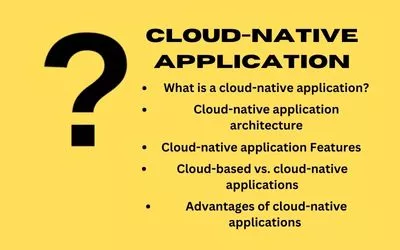What is a cloud-native application?
An application created specifically for a cloud computing architecture is known as a cloud-native application. These apps are intended to take advantage of the features that come with a cloud computing software delivery paradigm. They are hosted and operated in the cloud. Software that is created specifically for a particular platform or device is known as a native app.
Microservice architecture is used by cloud-native applications. Because of the effective resource allocation provided by this design, any service utilized by the application is able to flexibly accommodate a cloud architecture.
Cloud-native application architecture :-
The cloud computing frameworks and their loosely connected cloud services are leveraged by cloud-native applications. Cloud-native application developers need to employ software-based architectures to establish a network across computers because not all services are hosted on a single server. The services operate in various places and are hosted on several servers. Applications are able to expand out horizontally with this architecture.
On the other hand, cloud-native apps need to be designed with redundancy because the infrastructure supporting them doesn’t run locally. As a result, the application can automatically remap Internet Protocol (IP) addresses in the event of an equipment failure.
Cloud-native application Features :-
The cloud-native app architecture’s microservices are bundled into containers that connect to one another and exchange data via APIs. All of these elements are managed via orchestration tools.
The following are some of these applications’ primary functionalities:
Based on microservices: An application can be divided into a number of separate services, or modules, using microservices. Every service supports a distinct business objective and makes use of its own data. Application program interfaces are used by these modules to communicate with one another (APIs).
Container Based: Software known as containers allows a program to function independently of physical resources by logically isolating it. Microservices are prevented from interfering with one another using containers. They prevent apps from using up all of the shared resources on the host. Additionally, they permit several instances of the same service.
API-driven: Microservices and containers are connected via APIs, which also offer easier security and maintenance. They provide as a link between loosely linked services, facilitating communication between microservices.
Dynamic orchestration: Container lifecycles can get complicated, thus technologies for orchestration are employed to manage them. Resource management, load balancing, scheduling restarts following an internal failure, and provisioning and deploying containers onto server cluster nodes are all handled by container orchestration technologies.
Cloud-based vs. cloud-native applications :-
There is frequently confusion between cloud-native and cloud-based applications. Despite using public, private, or hybrid cloud infrastructures, they are not alike in terms of design.
Cloud-based applications
These are made to be used with cloud computing and cloud platforms. Applications that are cloud-based might leverage dynamic cloud infrastructure, but they don’t fully utilize the advantages that come with the cloud.
Cloud-native applications
These are created especially with the cloud in mind. Application development that is cloud-native is flexible enough to adjust to the ever-changing cloud environment while being optimized for the features built into the cloud
Advantages of cloud-native applications :-
Applications that are cloud-native are made to benefit from the cloud’s speed and effectiveness. Among the advantages of utilizing them are the following:
Cost-effective: Resources for storage and computation can expand as needed. This gets rid of the requirement for load balancing and overprovisioning of hardware. Cloud-native apps can be quickly launched and virtual servers may be added with ease for testing. In order to save time, money, and resources, containers can also be utilized to maximize the number of microservices running on a host.
Independently scalable: Every microservice can grow on its own and is logically separated. The other microservices won’t be impacted if one is modified to scale. A cloud-native architecture allows for the updating of certain parts of an application more quickly than others.
Portability : In order to prevent vendor lock-in, cloud-native apps are vendor-neutral and employ containers to move microservices between the infrastructure of several providers.
Reliable: Because these cloud-based apps use containers, if one microservice fails, it won’t affect neighboring services.
Best practices for cloud-native application development :-
- Automate: Automation makes it possible to provision cloud application environments consistently across many cloud providers. Infrastructure as code (IaC) is used to automate the process of tracking changes in a source code repository.
- Monitor: Teams should keep an eye on both the application’s usage and the development environment. Monitoring everything from the application to the supporting infrastructure should be simple thanks to the environment and the application.
- Documentation: Many teams contribute to the development of cloud-native apps, but often have little idea what other teams are working on. To keep track of updates and observe how each team is improving the program, documentation is essential.
If you read my article, visit:- SoftwareTestingLeaders.com
If you read my story, visit:- Monkey Testing In Software Testing
